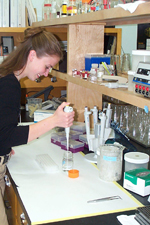Niklaus Grunwald,
USDA Agricultural Research Service, Prosser, WA
Sarah Fiedler, senior in the Prosser High School, Prosser, WA recently presented results from her Advanced Science Practicum. She conducted her own original research project with the objective of demonstrating that a fungal pathogen, with the scientific name Rhizoctonia oryzae, is the pathogen causing a new disease on pea. To demonstrate this, Sarah had to follow a series of steps of what are called Koch's postulates. These same steps are used to prove the pathogenicity of organisms isolated from diseased humans and animals.
 |
To complete the postulates, Sarah had to infect healthy plants with the pathogen, observe the same symptoms observed previously, and isolate the pathogen from the inoculated plants to prove that the same fungus used in the inoculations was recovered. In addition, Sarah also demonstrated that these isolates were genetically variable using a molecular technique known as Amplified Fragment Length Polymorphism (AFLP). Sarah worked with Dr. Niklaus Grunwald with the USDA Agricultural Research Service, Prosser, Washington. There is a simple and safe exercise in the K-12 lab section using a fungal disease of stone fruits to demonstrate Koch's postulates.
|

|
Views: Roses are without much doubt the favorite flower in most gardens in the U.S.A. A common problem for many gardeners is what often appears to be the early senescence of the blooms of their favorite varieties. Botrytis cinerea is a fungus that can cause the petals to turn brown and the entire flower to appear to 'collapse' almost overnight. Click image for an enlarged view and more information.
|
